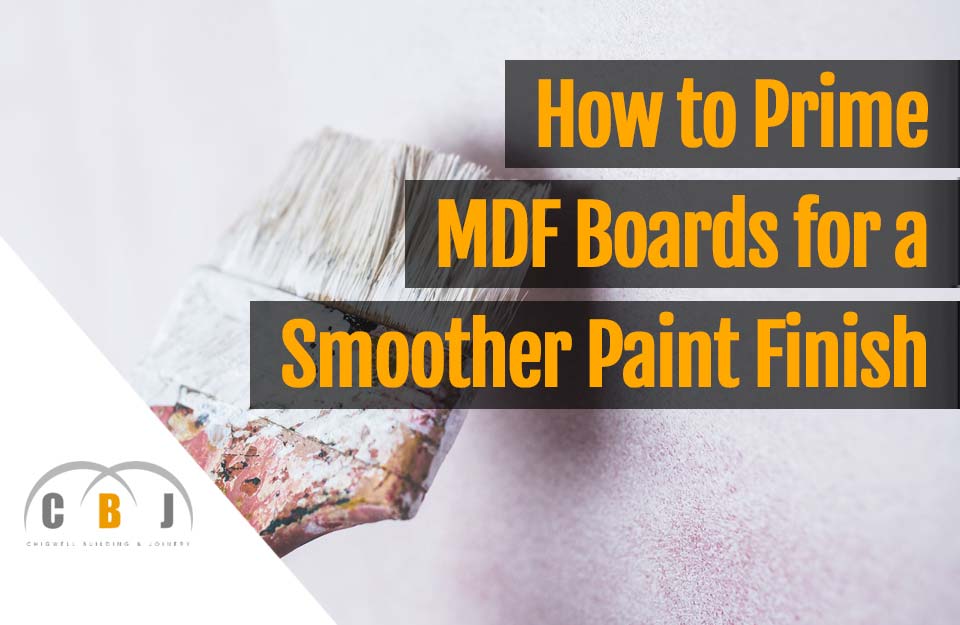
How to Prime MDF Boards for a Smoother Paint Finish
Author Chigwell Building & Joinery
Date 08/08/19
Priming and sealing is always recommended before you start painting MDF boards.
If you prime the MDF before painting, you will get a far better and neater finish.
This is because the paint finish will be smoother due to the underlying base coat.
Besides you will be able to prevent any distortions, especially as a result of swelling.
Let's look at what you should do step-by-step in greater detail.
Continue reading to find out how, or use the jump links below to skip to a chapter of your choice:
Chapters
- Sealing MDF Boards Edges
- Sealing MDF Boards with Drywall Sealer
- Sealing with Glue Based Primer
- Sealing MDF Board Surfaces
- Sealing with a Paint Primer
- Sealing with a Spray-on Lacquer
- Sealing with PVA Glue
- Sealing with an Enamel Primer
- Preparing, Priming & Painting MDF Boards
Sealing MDF Boards Edges
First of all, you should make sure to seal the edges of the boards well.
The surfaces also need to be sealed, especially since MDF is prone to moisture, which in turn causes swelling and splitting.
Sealing will also be critical if you intend to use water based paints.
Pay special attention to the edges as this is where the MDF board will be absorbing the paint most heavily.
And in case there are any routed details apply more sealer.
There are different kinds of sealer that you can use, including acrylic or drywall paint sealer, or oil based primer, or glue based primer.
Sealing MDF Boards with Drywall Sealer
Rub a coating of this primer into the edges of the boards.
Then wipe for a more even result, and sand the areas.
Sealing with Oil Based Primer
Apply onto the edges and leave to dry well. Then sand them down.
Sealing with Glue Based Primer
PVA glue can be spread as a thin layer over the edges of the boards.
A glue spreader can be used to do this more easily, or else you could apply it with an airbrush.
Just try to make sure that the layer is as smooth and as even as possible.
Do not allow any build ups.
Once it has dried well you can sand it lightly, paying attention to avoid sanding through the glue coating.
Sealing MDF Board Surfaces
The surface area of the boards can be sealed with different products, namely:
Sealing with a Paint Primer
Buy a paint primer that is suitable for MDF.
These primers are solvent, not water based.
These could include enamel or lacquer.
Pay attention when applying as these primers are rather thick, and in case you need to retain certain details they may not be ideal.
Sealing with a Spray-on Lacquer
Choose a clear or a coloured spray lacquer that is suitable for exterior finishes for best results.
Always follow the instructions on the product, and work in a well ventilated area.
Sealing with PVA Glue
Applying thin layers of PVA glue is another option.
Dilute with water so as to attain a thinner layer, or else opt for acid neutral PVA glue which is used for bookbinding as this can be easily applied.
In fact you could either use a roller or a spreader to apply it onto the boards, or else a spray bottle that is suitable for thinner glues.
Sealing with an Enamel Primer
The most important thing is to apply thin coatings.
Bear in mind that while applying it will be drying up rather quickly, and so you need to avoid having any build-ups accumulating.
Running and dripping will lead to an untidy result.
Make sure to choose a colour that will work well underneath the final coat.
Preparing, Priming & Painting MDF Boards
Once you choose which product to use for priming, follow these steps:
- Lay the MDF boards flat
- Wear gloves and start applying the primer on the edges of the boards first.
- Allow to dry well.
- To sand it is recommended to attach a sanding pad onto an oscillating tool, and fasten a sandpaper over it. Sand the edges you just primed.
- Then, sand lightly the surface area of the MDF boards so as to remove any fuzzy fibres which may be on the surface. This is common since MDF is ultimately a wood product composed of wood fibres packed up densely together.
- Wipe the surface of the boards with a rag to remove dust residue. Then use a tack cloth to get rid of any remains more effectively.
- Now you can start to apply the primer onto the surface area. Depending on the primer product you chose, you could use a spray bottle or a paint roller. Always spread evenly and as smoothly as you can. Wipe away any drops or running immediately.
- Allow the primer to dry thoroughly.
- Then, you can move on to the painting process.
Painted MDF looks much better, but it is important to prime it and sand it first.
Apart from a more aesthetically pleasing result, it will also increase its lifespan, as it is a type of material which easily absorbs water.
It is not difficult or time consuming to prime MDF boards, and you won’t need to sand it extensively either.

